
Padmasambhava, also known as Guru Rinpoche and the Lotus from Oḍḍiyāna, was a tantric Buddhist Vajra master from India who may have taught Vajrayana in Tibet. According to some early Tibetan sources like the Testament of Ba, he came to Tibet in the 8th century and helped construct Samye Monastery, the first Buddhist monastery in Tibet. However, little is known about the actual historical figure other than his ties to Vajrayana and Indian Buddhism.

The Sakya school is one of four major schools of Tibetan Buddhism, the others being the Nyingma, Kagyu, and Gelug. It is one of the Red Hat Orders along with the Nyingma and Kagyu.

Gampopa Sönam Rinchen was the main student of Milarepa, and a Tibetan Buddhist master who codified his own master's ascetic teachings, which form the foundation of the Kagyu educational tradition. Gampopa was also a doctor and tantric master. He authored the first Lamrim text, Jewel Ornament of Liberation, and founded the Dagpo Kagyu school. He is also known as Dvagpopa, and by the titles Dakpo Lharjé "the physician from Dakpo" and Daö Zhönnu, "Candraprabhakumara".

Drogön Chogyal Phagpa, was the fifth leader of the Sakya school of Tibetan Buddhism. He was also the first Imperial Preceptor of the Yuan dynasty, and was concurrently named the director of the Bureau of Buddhist and Tibetan Affairs, serving during the reign of Kublai Khan. Historical tradition remembers him as the first vice-ruler of Tibet under the Yuan emperor as well as one of the Five Sakya patriarchs. Although this is historically disputed, he played a very important political role.

Jamyang Khyentse Wangpo, also known by his tertön title, Pema Ösel Dongak Lingpa, was a renowned teacher, scholar and tertön of 19th-century Tibet. He was a leading figure in the Rimé movement.
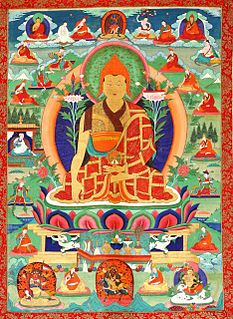
Tāranātha (1575–1634) was a Lama of the Jonang school of Tibetan Buddhism. He is widely considered its most remarkable scholar and exponent.
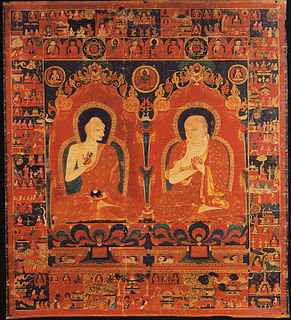
Butön Rinchen Drup, (1290–1364), 11th Abbot of Shalu Monastery, was a 14th-century Sakya master and Tibetan Buddhist leader. Shalu was the first of the major monasteries to be built by noble families of the Tsang dynasty during Tibet's great revival of Buddhism, and was an important center of the Sakya tradition. Butön was not merely a capable administrator but he is remembered to this very day as a prodigious scholar and writer and is Tibet's most celebrated historian.
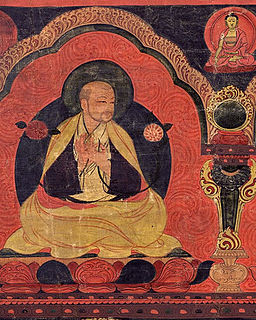
Sachen Kunga Nyingpo (1092–1158) was a Tibetan spiritual leader and the first of the Five Venerable Supreme Sakya Masters of Tibet. Sachen Kunga Nyinpo was the 3rd Sakya Trizin and son of Khon Konchok Gyalpo (1034–1102) who was the first Sakya Trizin and founder of the first Sakya Monastery in Tibet in 1073.
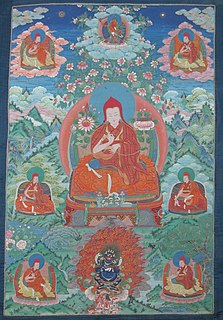
Sakya PanditaKunga Gyeltsen was a Tibetan spiritual leader and Buddhist scholar and the fourth of the Five Sakya Forefathers. Künga Gyeltsen is generally known simply as Sakya Pandita, a title given to him in recognition of his scholarly achievements and knowledge of Sanskrit. He is held in the tradition to have been an emanation of Manjusri, the embodiment of the wisdom of all the Buddhas.
Dakpo Tashi Namgyal was a lineage holder of the Dagpo Kagyu lineage of Tibetan Buddhism. He was also trained in the Sakya lineage, and "was renowned as both a scholar and yogi."
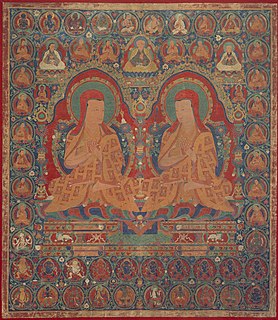
Ngor or Ngor Éwam Chöden is the name of a monastery in the Ü-Tsang province of Tibet about 20 kilometres (12 mi) southwest of Shigatse and is the Sakya school's second most important gompa. It is the main temple of the large Ngor school of Vajrayana Buddhism, which represents eighty-five percent of the Sakya school.
Ngorchen Konchog Lhundrub was a Tibetan Buddhist monk, abbot, teacher and writer.
Lamdré is a meditative system in Tibetan Buddhism rooted in the view that the result of its practice is contained within the path. The name "lamdré" means the “path" with its fruit Wylie: ‘bras). In Tibet, the lamdré teachings are considered the summum bonum of the Sakya school.

Phagmo Drupa Dorje Gyalpo [1110-1170], was one of the three main disciples of Gampopa Sonam Rinchen who established the Dagpo Kagyu school of Tibetan Buddhism; and a disciple of Sachen Kunga Nyingpo [1092-1158] one of the founders of the Sakya school of Tibetan Buddhism. He was the elder brother of Kathog Dampa Deshek [1122-1192], who founded Kathog monastery and the Kathog branch of the Nyingma school.
Ngor is a sub-sect of the Sakya tradition of Tibetan Buddhism. The main monastery of the Ngor sect is the Ngor monastery of Evam Choden about 20 kilometres (12 mi) southwest of Xigazê.

Ratna Vajra Rinpoche, is a Tibetan Buddhist teacher and the 42nd Sakya Trizin, considered one of the highest qualified lineage masters of both the esoteric and exoteric traditions of Buddhist philosophy and meditation. He is a descendant of the famous Khon family in Tibet, which holds an unbroken lineage of great and famous masters for over a thousand years. He is the eldest son of the 41st Sakya Trizin Ngawang Kunga. He teaches Buddhism and travels extensively throughout Europe, Asia, Australia, New Zealand and North America. Ratna Vajra was enthroned as the head of the Sakya school on 9 March 2017. On 16 March 2022, the throne of the Sakya school was passed by Ratna Vajra to his younger brother Gyana Vajra, who became the 43rd Sakya Trizin.
Jetsunma Chime Tenpai Nyima was a Tibetan Buddhist master, the only female master of the Sakya Vajrayoginī lineage. She is also considered a great siddha and an emanation of Vajrayoginī. She was born in Tibet and originally had the name Chime Butri. She was part of the prominent Sakya Khon family, which established itself by the 11th century in Sakya, Tibet. She studied with her uncle Kunga Lodro, who had had a vision prophesying, among other things, that she would be one of the closest disciples who would carry on his teachings. He transmitted to her the core Sakya Lamdre and the Vajrayogini teachings, among others. In 1782, she took novice vows from the twenty-fifth abbot of the Sakya Lhakhang Chenmo, Jampa Chokyi Tashi, who gave her the ordination name by which she has come to be known, Chime Tenpai Nyima.
The Imperial Preceptor, or Dishi was a high title and powerful post created by Kublai Khan, founder of the Yuan dynasty. It was established as part of Mongol patronage of Tibetan Buddhism and Yuan administrative rule of Tibet.
Khön Könchok Gyalpo was the founder of the Sakya School of Tibetan Buddhism, and the founder of Sakya Monastery. Khön Könchok Gyalpo was born in Sa'gya, Tsang. He was a member of the Khön family, and his ancestry can be traced back to Khön Dorje Rinpoche, student of Padmasambhava. He followed his father and brother and learned doctrines of the Nyingma School at a young age, but studied newly translated Vajrayāna texts with Drogmi Shakya Yeshe later. Khön Könchok Gyalpo established Sakya Monastery in 1073, where the Sakya Tradition first developed. His son Khön Kunga Nyingpo was regarded as the first leader of Sakya, and Khön Könchok Gyalpo is known as the first Sakya Trizin.
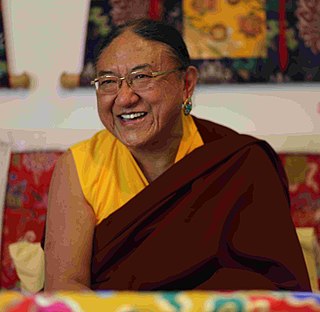
Sakya Trizin Ngawang Kunga served as the 41st Sakya Trizin, the throne holder of the Sakya Lineage of Tibetan Buddhism, from his appointment in 1952 until his retirement in 2017. His religious name is Ngawang Kunga Tegchen Palbar Trinley Samphel Wangyi Gyalpo. After passing the throne of the Sakya lineage to his elder son Ratna Vajra Rinpoche who became the 42nd Sakya Trizin on 9 March 2017, he is now known as Kyabgon Gongma Trichen Rinpoche. He is considered second only to the Dalai Lama, in the spiritual hierarchy of Tibetan Buddhism.













